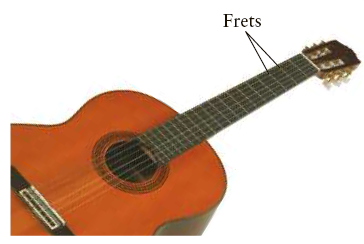The neck of a guitar is designed with frets as shown in Figure Q12.8. A player can
Question:
The neck of a guitar is designed with frets as shown in Figure Q12.8. A player can hold a string against one of the frets and thus shorten the vibrating length L of the string. In this way, a particular string can be used to play notes with different frequencies. The frequency of a note is determined by the fundamental standing wave mode (Fig. 12.24), and this frequency depends on L. In a musical scale, the frequencies of adjacent notes (i.e., between C and C-sharp) are in the ratio of 21/12/1 1.059; this ratio produces the commonly used 12-tone musical scale. The artisans who make guitars position the frets according to the ?rule of 18ths.? According to this rule, each fret is positioned so that depressing adjacent frets shorten the vibrating length of the string by L/18. (See Fig. Q12.8.) Show that the rule of 18ths produces note frequencies that fit approximately on the desired musical scale.
Figure Q12.8
?
Step by Step Answer:

College Physics Reasoning and Relationships
ISBN: 978-0840058195
2nd edition
Authors: Nicholas Giordano





